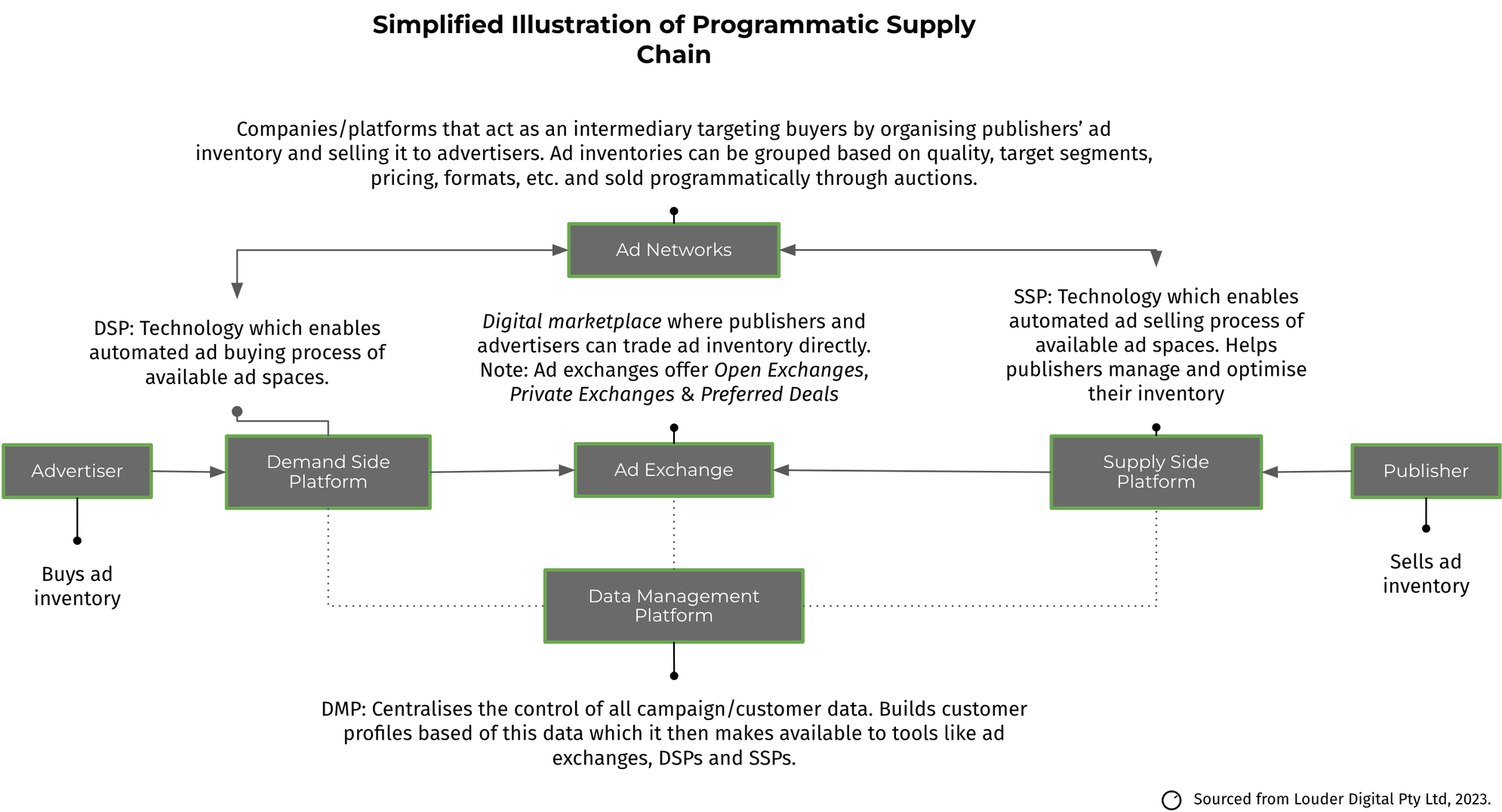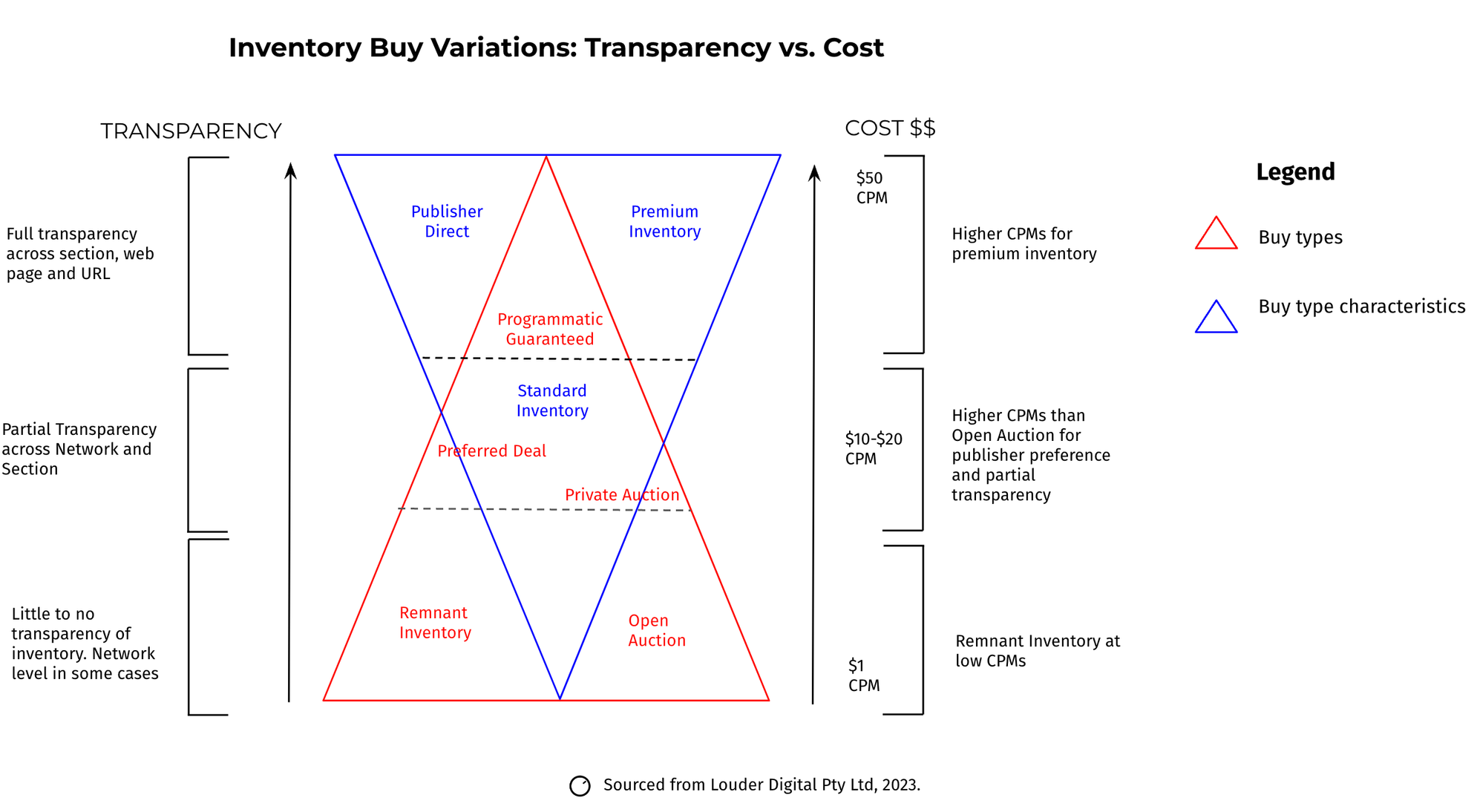12 March 2024
Programmatic supply path cops and robbers

In summary
- The programmatic supply chain is under increased scrutiny so we aim to take a look at all the players and the ever growing demands of the ecosystem
- The cost to quality conundrum is ever present so it’s important buyers are informed in order to begin defining the value of an impression and it’s outcomes
- Curation is now readily available for buyers to become more purposeful and carve out niche supply that meet increasing demands for transparency and sustainability
- Liquidity / supply is always variable based on demand, and accordingly, pricing fluctuations in a market such as Australia are common, particularly in limited inventory environments such as video
Supply path ecosystem
The programmatic ecosystem has evolved in a manner that has allowed advertisers to be better connected with publishers like we have never seen before, enabling buyers to immediately transact more precisely in scaled environments across various channels and formats. There is more choice than ever in what can now be bought and how, demand side platform (DSP) enhancements to bidders and audience enrichment are beginning to move brands into a predictive era of automation.
However, the supply chain is increasingly being put under the microscope in recent times due to the vast array of exchanges operating in the ecosystem, alongside various malicious practices, ticket clippers, inventory resellers and back-ended commercial deals masquerading as marketplaces. Huge works have been undertaken in recent years to improve both quality, transparency and accountability in the supply chain.
Changes in the ecosystem
Whilst DSPs have continued to raise the bar from a measurement and transparency perspective through improved verification and brand safety features, it’s clear now that we rightfully scrutinise the supply pastures where there are increased inventory demands for measurable outcomes in the form of sustainability, attention and transparency. The 2023 Programmatic Media Supply Chain Transparency Study released by ANA puts the responsibility on brands directly to enforce greater standards through stronger governance. By highlighting that just 36 cents of the programmatic dollar were served to an on-target audience, the report shows there is plenty of opportunity for brands and agencies to improve supply path avenues.
Illustrated below is a basic overview of the various technologies that may be involved in a simple programmatic purchase. Manipulation of the supply chain within some of these ad tech platforms is very much possible and will be discussed within this piece.
Supply curation
In an age where supply paths are becoming increasingly complex and costly due to the ecosystem’s multi-vendor nature, supply path curation aims to promote governance and policy over the media, including the programmatic supply chain with strategies based on data and insights intending to increase transparency and accountability. Supply curation allows inventory to be sourced and purchased in the most efficient manner, whilst addressing and optimising for key goals surrounding quality, costs, transparency, verification & sustainability.
So what’s considered good supply?
A well curated supply path should be meeting minimum brand hygiene metrics (VTR, viewability, etc.) that conforms with the end advertiser’s media policy and buying criteria. This should guide value that comes back to both delivering on basic campaign objectives and conforming with foundational media policy and governance (i.e. brand safety application). Format and channel considerations can also guide supply via the local publisher mix to determine sourcing (open exchange vs private marketplace buys) that conforms with a business (end advertiser’s) media policy and buying criteria.
What to look out for
Increasingly, outcome-based automated buying paths are rising in popularity, which although meet short-term outcomes (i.e CPA, CPC goals), they do so with little regard for brand health. Such solutions are often typified by AI-powered methods that reduce control and transparency, which can mean potentially serving on unwanted content with poor creative or an undesirable channel mix in order to achieve key objectives. Less control over supply ripens the path for providers to dictate inventory decisions where margins can be made without the knowledge of the buyer in a black box manner, making it important to steer clear of these buy types if brands are to have any control over the supply path.
Supply value and quality
Defining quality should not simply be associated with premium labels on inventory sources. Full use of the supply chain from a premium to remnant inventory perspective should be strategised to programmatically meet audience, behaviour and contextual needs.
Traditionally, value has always been associated with ‘premium’ costs, however if an impression can be bought on the open exchange on the basis of an on-target audience and verified through DSP brand controls, then we should be considering the value of open exchange buying to cost-effectively reach desired audiences at scale. The scarcity of certain inventory types however, (i.e. BVOD), can be the catalyst for guaranteed buying methods via direct publisher/exchange relationships to meet volume needs.
Illustrated below is the cost/quality and transparency view which speaks to the perceived dynamics of inventory layered with various buy types available in the marketplace.
Understanding what quality impressions mean for a buyer’s campaign will help determine the most appropriate methods of curation and tailor it to their needs. Following this, gathering supply related log level data made available within owned tech will enable buyers to analyse where in the supply chain they are receiving the most value, based on their set definition. Long-tail parties can then be excluded from DSP level targeting to improve quality of source. In addition to this, blocklists and allowlists can also be carefully curated as part of basic brand safety measures to further improve inventory quality and curation of supply.
The overarching aim is to understand where inventory is coming from and whether it provides value to the buyer or not. Hence, it also goes without saying that blackbox inventory supply does not help achieve this goal and thus should be avoided as much as possible. Working with traceable inventory, especially with the assistance of third party verification/measurement services, will allow for a more effective use of ad dollars.
Sustainability in advertising
Sustainability and the impact of advertising is now a consideration for many brands, with its inclusion in their media policy and governance positions., and although some may feel this is added confusion to the supply path, stronger governance around supply chains can actually assist in promoting sustainability.
Simply put, the reduction of what tends to be dozens of ad exchanges and supply side platforms (SSP) targeted in individual bids, down to a handful of high quality partners can result in limiting the amount of data exchanged between the various parties. This can assist in limiting bid requests whilst also reducing non-viewable ad serving - two important facets in promoting sustainable programmatic operations.
This curation directly addresses key problems that result from the nature of programmatic, where multiple SSPs may offer the same impression, creating duplicate auctions and longer supply paths, leading to both higher bids and higher energy consumption.
We will likely see in Q3 and Q4 of 2024 substantial challenges with smaller exchanges and SSPs being affected by the 3P cookie deprecation resulting in a shift to more mainstream and scaled technology vendors. This may have a knock on effect of reduced latency for customer ad-rendering, and speed up publisher’s sites, improving user experiences.
Sustainable methods of buying
Using platform supply reports or log-level data gained through data transfer report files to weed out long-tail exchanges and SSPs, the nature of open exchange DSP targeting becomes more efficient, with reduced latency across the shortened supply path before an impression is served. Further, with such curation comes increased inventory quality, where the number of Made for Advertising (MFA) invalid sites floating around in the mandated supply chain is lowered, leaving less opportunity for low viewability and wasted impressions to take place.
Direct paths through guaranteed or preferred deals can also help limit bid requests and promote viewability standards, with inventory that can be vetted beforehand to determine suitability and quality of supply.
Both exemplar methods allow the same, if not higher quality inventory to be bought through established supply paths instead of utilising many of the numerous paths made available within the ecosystem, all of which can help optimise costs and energy consumption thereby establishing a smarter, more sustainable supply process.
Next steps
If you are interested in taking control and understanding your supply in a more intimate manner, Louder can support supply path optimisation (SPO) efforts through strategic services such as:
- Allow and blocklist development
- MFA avoidance strategies - vendor enabled or manually vetted
- Exchange and domain level audit and analysis - vendor selection
- Brand safety best practices
Louder can also consult to develop robust Media Policy & Governance policies for brands which covers:
- Media buying standards and supply procurement transparency
- Media buying technology and vendor category assessments
- Design and development of platform governance and controls
Intrigued? Get in touch and have a chat to the team at Louder for more information on our services. Additionally, sign up to our newsletter to receive industry and platform news and more articles like this one right in your inbox!



